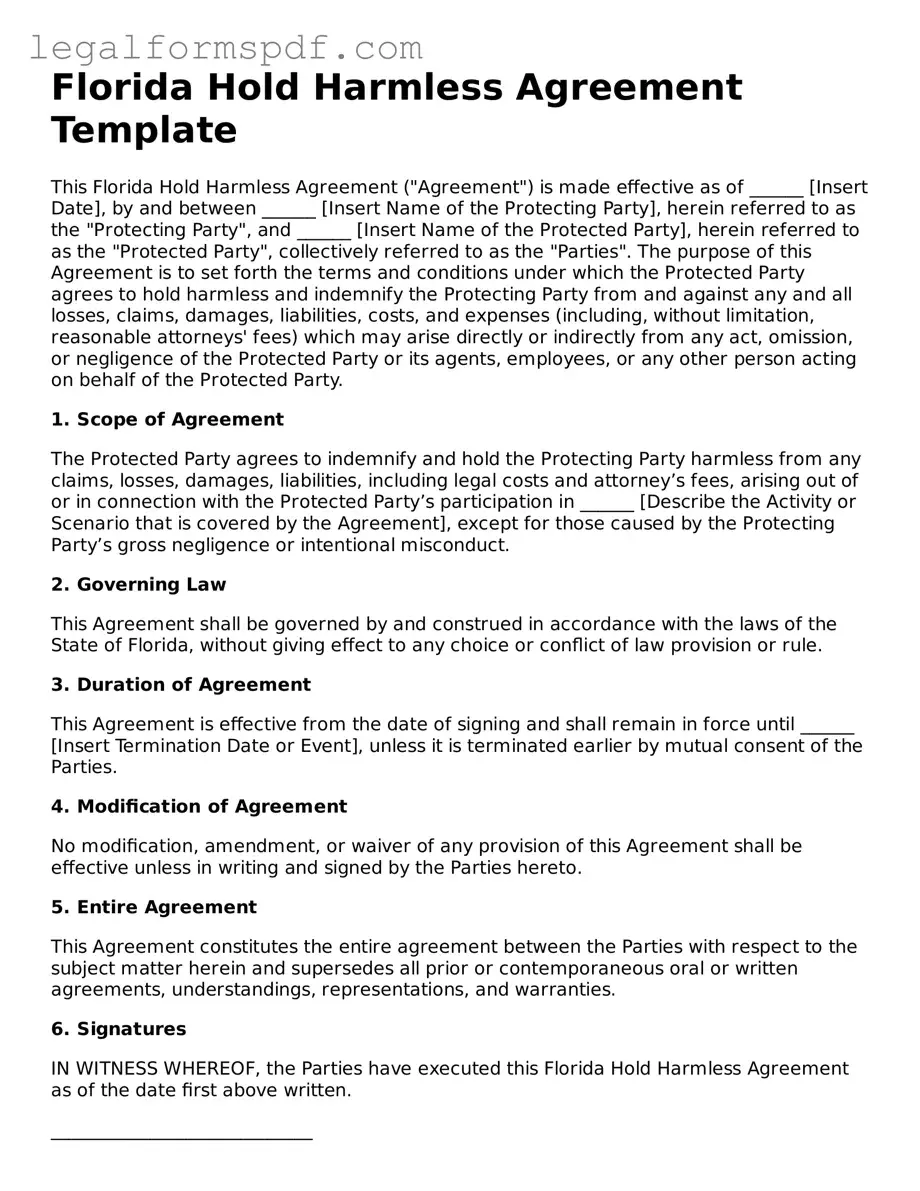Florida Hold Harmless Agreement Template
This Florida Hold Harmless Agreement ("Agreement") is made effective as of ______ [Insert Date], by and between ______ [Insert Name of the Protecting Party], herein referred to as the "Protecting Party", and ______ [Insert Name of the Protected Party], herein referred to as the "Protected Party", collectively referred to as the "Parties". The purpose of this Agreement is to set forth the terms and conditions under which the Protected Party agrees to hold harmless and indemnify the Protecting Party from and against any and all losses, claims, damages, liabilities, costs, and expenses (including, without limitation, reasonable attorneys' fees) which may arise directly or indirectly from any act, omission, or negligence of the Protected Party or its agents, employees, or any other person acting on behalf of the Protected Party.
1. Scope of Agreement
The Protected Party agrees to indemnify and hold the Protecting Party harmless from any claims, losses, damages, liabilities, including legal costs and attorney’s fees, arising out of or in connection with the Protected Party’s participation in ______ [Describe the Activity or Scenario that is covered by the Agreement], except for those caused by the Protecting Party’s gross negligence or intentional misconduct.
2. Governing Law
This Agreement shall be governed by and construed in accordance with the laws of the State of Florida, without giving effect to any choice or conflict of law provision or rule.
3. Duration of Agreement
This Agreement is effective from the date of signing and shall remain in force until ______ [Insert Termination Date or Event], unless it is terminated earlier by mutual consent of the Parties.
4. Modification of Agreement
No modification, amendment, or waiver of any provision of this Agreement shall be effective unless in writing and signed by the Parties hereto.
5. Entire Agreement
This Agreement constitutes the entire agreement between the Parties with respect to the subject matter herein and supersedes all prior or contemporaneous oral or written agreements, understandings, representations, and warranties.
6. Signatures
IN WITNESS WHEREOF, the Parties have executed this Florida Hold Harmless Agreement as of the date first above written.
_____________________________
Signature of the Protecting Party
_____________________________
Signature of the Protected Party
Notary Acknowledgment
State of Florida
County of ______
On ______ [Insert Date], before me, ______ [Insert Name of Notary], personally appeared ______ [Names of the signed Parties], who proved to me on the basis of satisfactory evidence to be the person(s) whose name(s) is/are subscribed to the within instrument and acknowledged to me that he/she/they executed the same in his/her/their authorized capacity(ies), and that by his/her/their signature(s) on the instrument, the person(s), or the entity upon behalf of which the person(s) acted, executed the instrument.
_________________________________
Signature of Notary Public
My commission expires: ______
